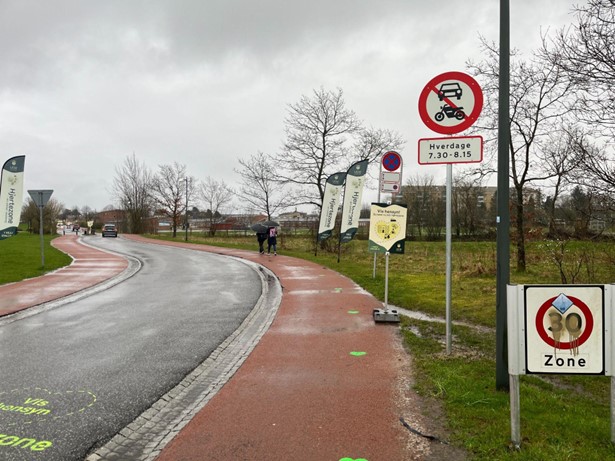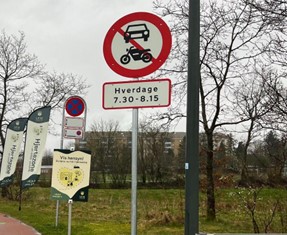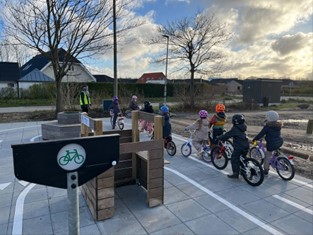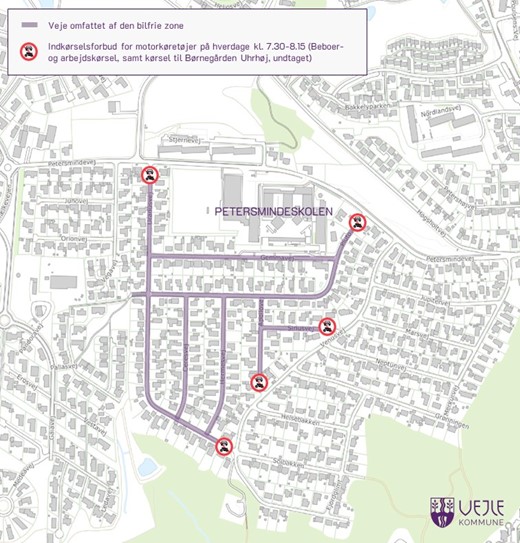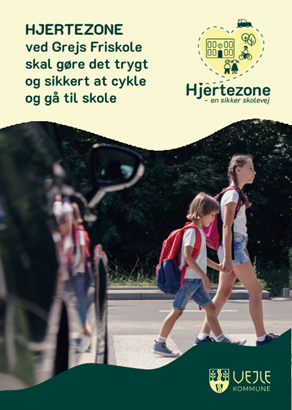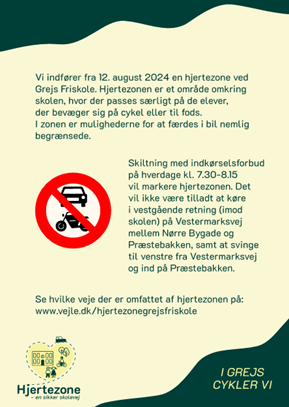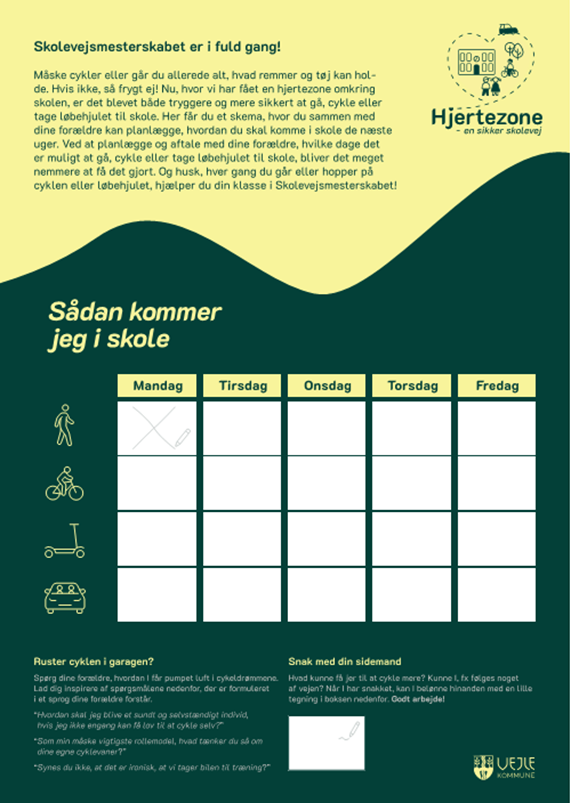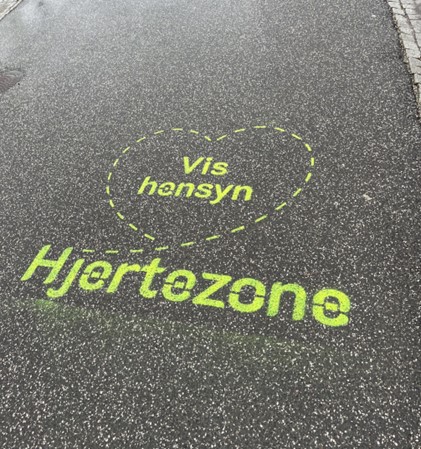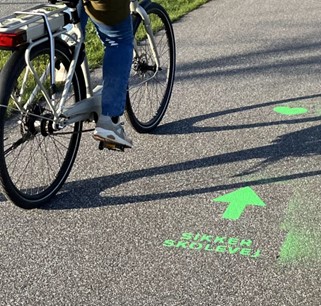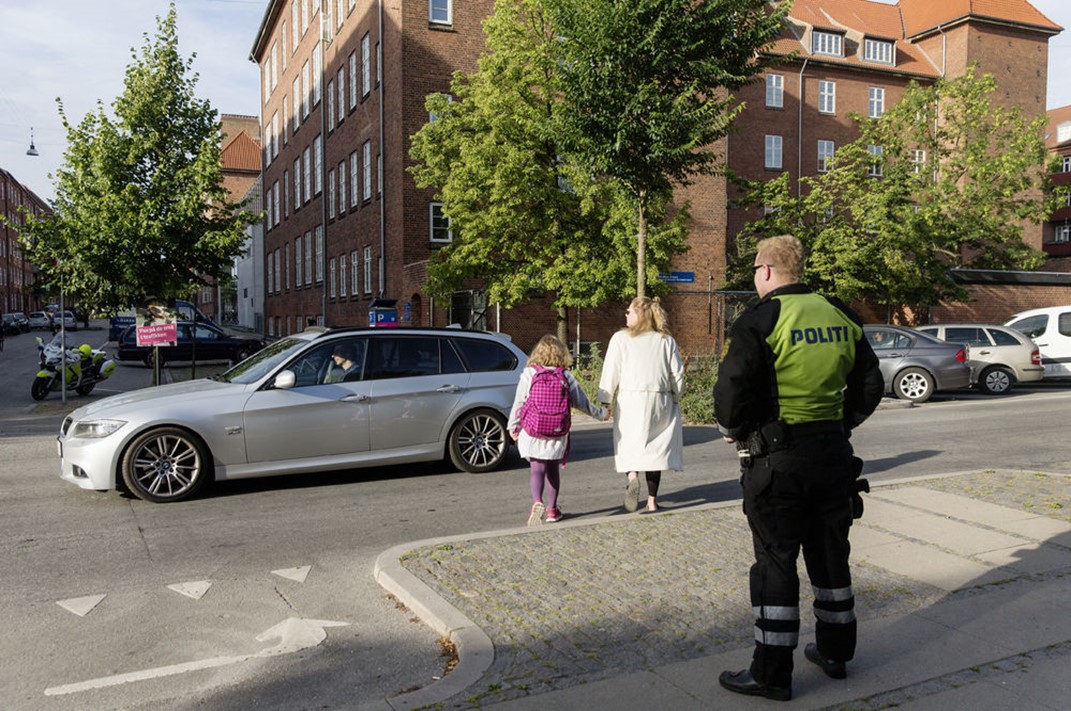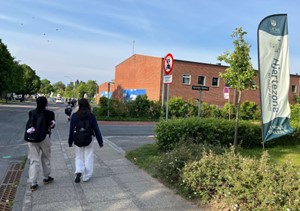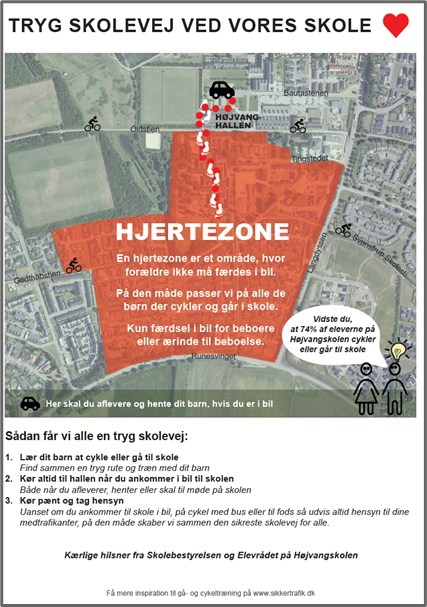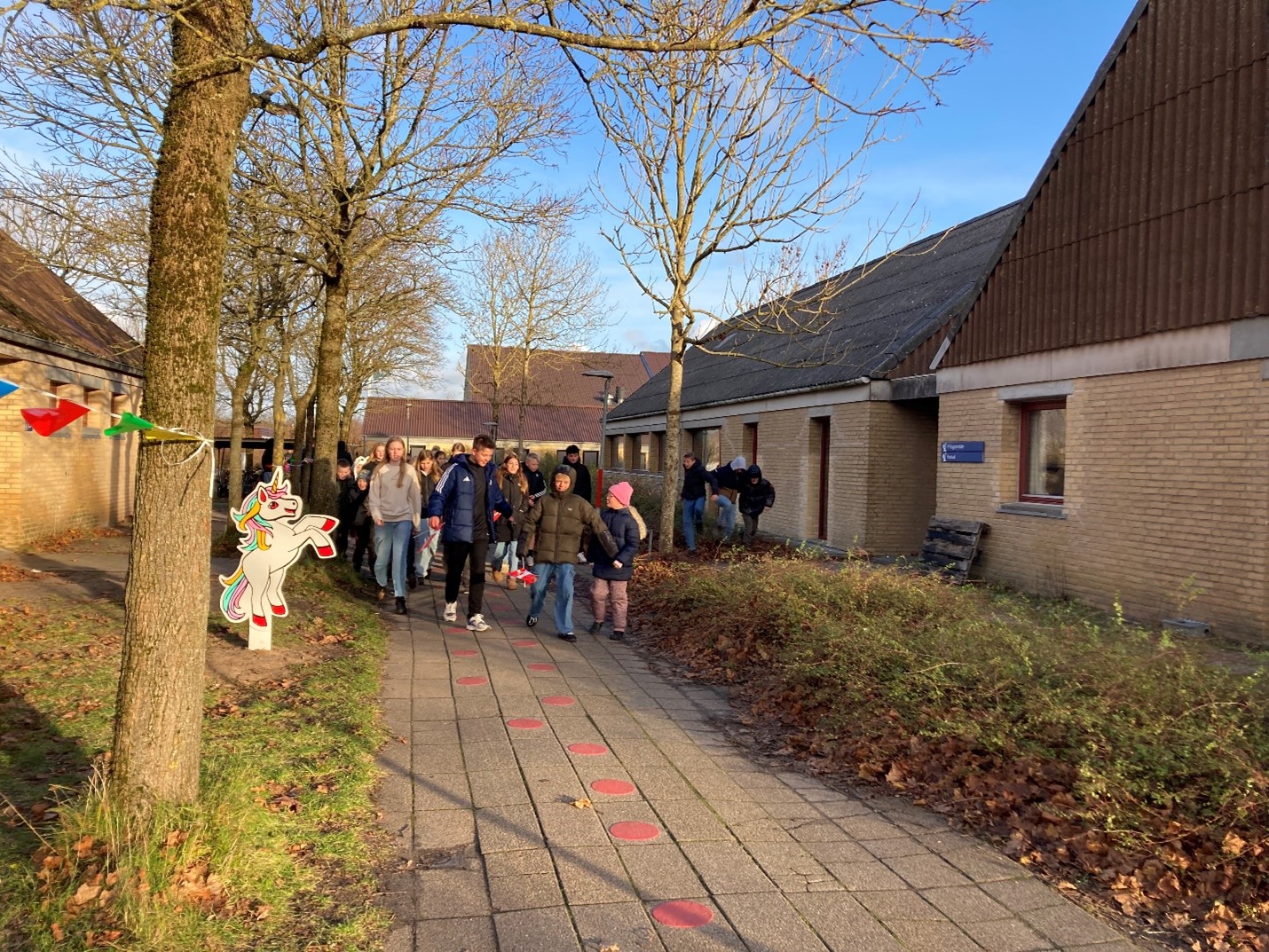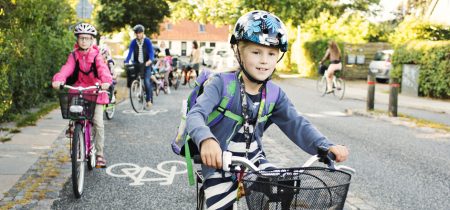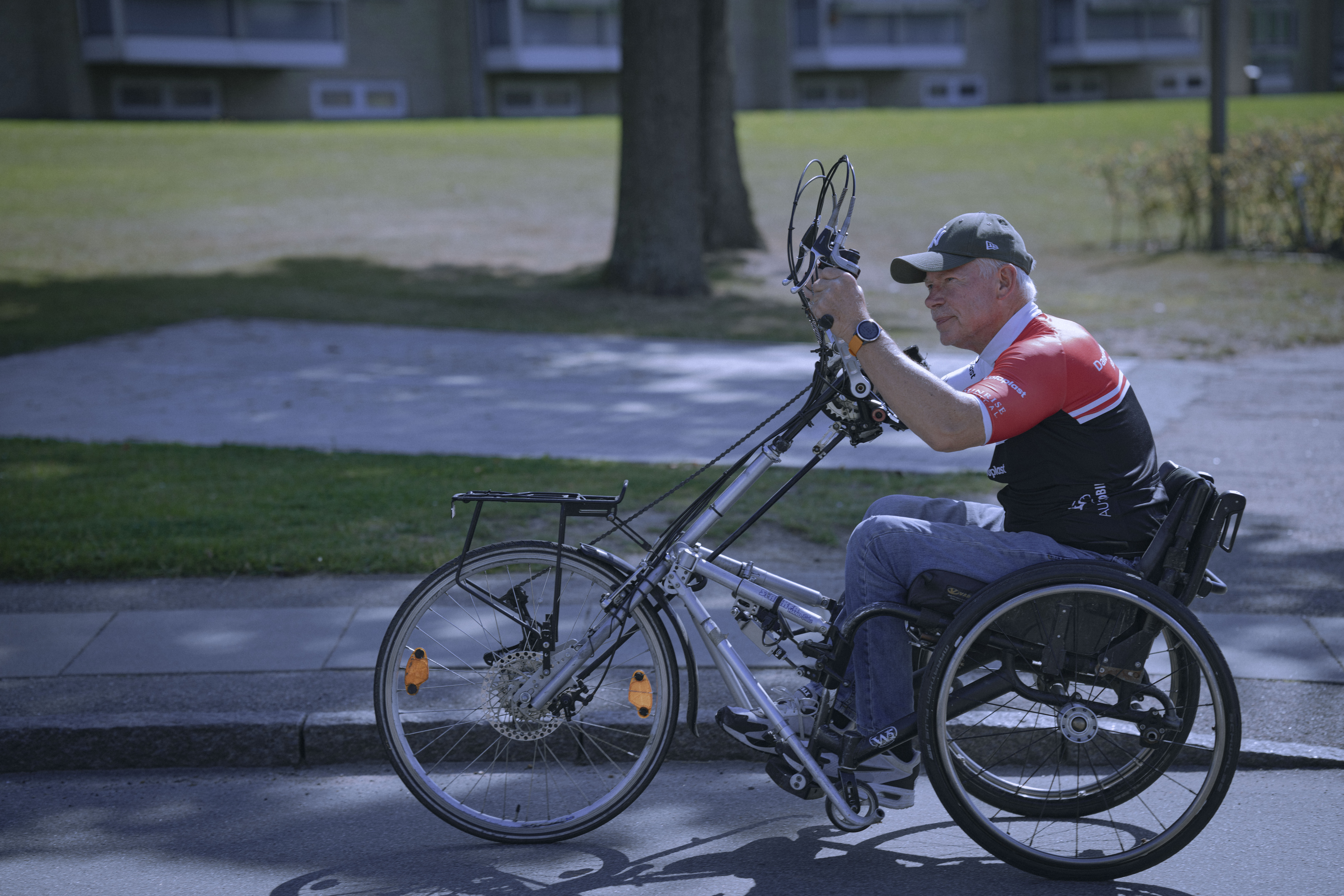School Zone Traffic Calming (Heart zones)
Many cars near schools create chaotic and unsafe arrival conditions for children. Heart Zones are an effective way to calm traffic around schools, making it safer for children to walk and cycle. In recent years, more and more municipalities in Denmark have started establishing Heart Zones around schools. The experiences have been positive. Children and parents feel safer walking and cycling, and more families choose these transportation options.
By Mette Olesen, Aalborg Municipality; Majken Kobbelgaard Andersen, Vejle Municipality; Anette Jerup Jørgensen, Copenhagen Municipality
Inspired by Norwegian models, several Danish municipalities have implemented Heart Zones near schools to counter the growing trend of parents driving their children to school instead of letting them walk or cycle.
Nationwide studies show that fewer children in Denmark walk or cycle to school. The number of kilometers cycled by children aged 10-17 dropped by 24.5% from 2009 to 2019. Although most children live relatively close to their schools—65% within 2 km and 77% within 3 km—many are still driven due to safety concerns.
Example of a “Heart Zone”
Heart Zones: Calming Traffic Around Schools
Though serious accidents involving children on their way to school are rare, parental concerns persist. Many parents feel unsafe due to cars reversing, speeding, and blocking visibility near schools. National surveys reveal that 3 out of 10 parents and 1 out of 4 students feel unsafe on the way to school.
Heart Zones reduce traffic near schools, creating safer environments for children. Parents and students report feeling safer, and fewer students are driven to school after Heart Zones are implemented.
Key Considerations for Establishing Heart Zones
- Traffic Culture and Perceived Safety:
Physical measures (signs, traffic regulations) must be supplemented by strong school leadership emphasizing traffic safety culture. - Context and Implementation:
Schools can participate voluntarily or by political mandate, each having unique advantages and challenges regarding communication, willingness to change, and sustainability. - Collaboration with Police:
Involving police in planning and follow-up ensures better enforcement and traffic management.
What defines a Heart Zone?
Danish municipalities today use various terms for the same concept, including “Heart Zone,” “School Zone,” “Car-Free Zone,” and “Safety Zone.” Despite the different terms, they all refer to the same concept. In this article, we consistently use the term “Heart Zones.”
A Heart Zone is an area around a school where car traffic access is restricted. The purpose is to create safe and secure conditions for children walking and cycling to school. By reducing car traffic in the zone, a safer environment is created, especially for pedestrians and cyclists.
What Does a Heart Zone Look Like?
There is no specific marking (such as signs or symbols) for Heart Zones in Denmark. However, some municipalities use campaign materials such as posters and flags to highlight Heart Zones and communicate the concept. These materials are usually used temporarily, after which the Heart Zone consists of other traffic control measures.
These measures often include:
- No Entry: Prohibiting vehicle entry
- One-Way Streets: Managing traffic flow
- No Parking or Stopping: Preventing vehicle obstruction
- Road Closures: Blocking motorized traffic
The measures can also be time-limited, applying only during peak traffic times, such as weekdays from 7:30 to 8:15 am, when school traffic is typically most intense. Exceptions may be made for residents, delivery vehicles, or special needs transportation.
In some places, private cars may be allowed to enter if necessary for students or parents with disabilities, ensuring they can participate in school activities.
Examples of a Heart Zone in Vejle – street view and map:
- Eksempel på en hjertezone i Vejle set på kort

- Example from Belgium – the use of manually operated barriers that block half of the roadway during periods with entry restrictions
Implementation and Enforcement
In Belgium, manually operated barriers managed by school staff block roads during morning arrival times. In Norway, systematic work includes designated drop-off zones for cars. In Denmark, drop-off locations are determined on a site-specific basis.
If nearby parking spaces are available, parents are directed there. Otherwise, parents must find suitable drop-off points outside the Heart Zone. If drop-off chaos arises after the Heart Zone is established, adjustments are made, such as creating new drop-off areas or expanding the Heart Zone. In most cases, such adjustments are unnecessary, as parents usually drop off children further away from the Heart Zone.
Communication and Behaviorial Measures
While traffic signs are essential, implementing a Heart Zone should be accompanied by a comprehensive communication campaign and behavior-influencing measures that support its physical design.
Informing parents, students, local residents, and school staff about new traffic conditions is important. Relevant stakeholders such as institutions, businesses, and emergency services should also be involved in the planning phase. Public marketing efforts may increase public awareness of Heart Zones.
Behavioral measures may include:
- Nudging Campaigns: Promoting specific school routes
- Competitions: Encouraging walking and cycling
- Traffic Education: Integrating cycling into the school curriculum
Unused parking areas could be repurposed as cycling training areas or exercise zones where schoolchildren can learn traffic rules.
Picture 1 and 2: example of postcards handed out to students and parents. Picture 3: example of a planning tool. The sheet was printed and distributed to all students to encourage conversations between children and parents about transportation to school.
Examples of different campaign measures.
How to make a Heart Zone?
Several approaches exist for implementing Heart Zones. Often, municipalities’ mobility departments initiate the projects as part of safe school route strategies. Projects are typically organized in collaboration with school management, school boards, and sometimes even students.
Experience shows that the best results come from coordinated efforts among road authorities, schools, parents, and students. In some cases, municipalities have made political decisions to establish Heart Zones without involving stakeholders beyond traffic authorities. While this streamlines implementation, it can reduce compliance and community support.
Collaboration with schools and parents is crucial. Schools influence students’ and parents’ behavior, while parents decide how their children travel. Therefore, understanding, engagement, and ownership from parents are vital for a Heart Zone’s success.
Involving students has proven valuable, as they offer a unique perspective on school routes and can communicate the benefits of Heart Zones effectively.
Political Support
Political support plays a crucial role in implementing Heart Zones. Politicians decide to allocate resources and prioritize these initiatives, making it possible to implement concrete measures. Schools recognizing Heart Zones as a political priority may be more willing to cooperate.
By 2028, Copenhagen, Vejle, and Aalborg municipalities plan to expand Heart Zones, continually evaluating their effectiveness through surveys, traffic data, and community feedback.
Case examples
Copenhagen – Signage, Information, and Control
Copenhagen has a total of 130 schools. It has been politically decided to establish Heart Zones—called Safety Zones in Copenhagen—at up to 70 of the city’s primary schools. Before this decision, the municipality screened the roads around all schools and identified potential locations at 70 schools.
Although the establishment of the zones was politically mandated, they are only implemented where there is support from local councils, schools, institutions, businesses, and residents in the area. This requires close dialogue with local stakeholders and consultations in areas where schools are surrounded by private shared roads.
In the Heart Zone, motor vehicle access is prohibited during students’ morning arrival times—typically between 7:30 and 8:30 am. Resident and work-related traffic is allowed from specific access points within the zone. In some schools, exceptions are made for motor vehicle drivers with special permits to accommodate students and parents with disabilities when necessary for student attendance and parental participation in school activities.
When a zone is established, parents receive information brochures through the schools’ and institutions’ digital platforms. Residents in affected areas receive email notifications. Additionally, the initiative is broadly communicated through local media, the municipality’s social media channels, and other platforms. The effort is coordinated closely with the Copenhagen Police. Police monitoring is essential to ensure the initiative’s effectiveness, particularly on roads with significant through traffic in addition to school-related traffic.
Between 2022 and 2023, zones were established at the first 10 schools. Feedback from school leaders, parents of schoolchildren, and residents indicates that the Safety Zones have created calmer and safer school routes. Although some schools and daycare institutions report that not all parents comply with the entry ban, there are now fewer cars on the roads and more manageable conditions for the children.
The police report that most drivers comply with the entry ban. The system works best at schools surrounded by smaller residential streets and in neighborhoods primarily characterized by local traffic to schools, institutions, homes, and businesses. In areas with heavy through-traffic, police presence is needed more frequently to enforce the entry ban.

Example of a poster for display at school entrances
- Police Monitoring at Ny Carlsbergvej near Vesterbro New School
Ny Carlsbergvej near Vesterbro New School is Copenhagen’s most challenging Heart Zone. Continuous monitoring is necessary due to significant non-local through-traffic.
From 2024 to 2028, a city-wide initiative will establish Safety Zones around an additional 60 schools. Measurements of students’ perceived safety and transport habits will be conducted to identify the quantitative impact of the Safety Zones.
Vejle – Signage, Campaigns, and Communication
In the past two years, Heart Zones have been established at three schools in Vejle. The projects began as pilot trials lasting 8-16 weeks and were later made permanent based on evaluations.
In Vejle, there is a political ambition to establish Heart Zones where local support exists. The solutions were developed in close collaboration with schools and school boards, including traffic signs, physical measures, and campaign elements to increase Heart Zone visibility and influence behavior through marketing and communication.
Traffic Measures:
- Entry bans on weekdays during the morning
- Parking and stopping bans
Several models were tested, including a complete ban on motor traffic from 7:30 to 8:15 am on weekdays, with exceptions for residents and work-related traffic. One-way traffic restrictions were also tested to direct traffic in front of the schools.
Communication and Campaigns:
E-boks notifications were sent to all affected parties, and both school and municipal communication channels were used. Physical materials such as postcards, roadside posters, asphalt markings, and beach flags were distributed. Campaigns targeted students through competitions, planning tools, reflective gear, and promotional events.
Schools hosted opening events, walking and cycling competitions, and emphasized cycling and traffic culture during pilot periods. Temporary markings with dots and hearts guided students along safe school routes.
Evaluation Results:
Data on student transport habits, perceived safety, traffic counts, surveys, and stakeholder meetings show that car traffic has been significantly reduced, while walking and cycling have increased. School route safety has also improved.
Heart Zone at NOVA School in Vejle. Entry bans on central roads near the school, with visibility enhanced by beach flags, roadside posters, and pavement markings.
Aalborg: Holistic School Case Approach
Aalborg has 48 municipal schools. The Heart Zone initiative began with Højvangsskolen as a pilot project. Each year, the municipality selects two schools for pilot projects lasting about two years, meaning there are always four active projects.
Students, parents, school management, and other stakeholders are involved, and traffic analyses are conducted. This forms the basis for deciding which measures to implement, targeting both physical infrastructure and behavior change.
Key Insights:
- School drop-off situations near schools often create unsafe conditions.
- Heart Zones can reduce this by spreading traffic over a larger area and directing cars to designated drop-off locations.
The first Heart Zone was implemented at Højvangsskolen in November 2023. The school’s surrounding area was calmed by directing all student drop-offs to Højvanghallen, which has over 100 parking spaces. A 250-meter pedestrian path from the hall to the school is accessible via a closed path system.
Student Engagement Activities:
- Walking buses
- Red dots and solar-powered lights guiding the way
- Conversion of the school parking lot into a cycling playground designed with student input
- Permanent road closures for all motor traffic except for local residents and work-related traffic
Evaluation Results:
Before implementation, 74% of Højvangsskolen’s students already walked or cycled to school, compared to the municipal average of 58%, but the evaluation still shows improvements:
- 6% of students previously driven now walk or cycle to school.
- 60% believe general traffic safety has improved (10% think it has worsened).
- 52% feel safer sending their children on foot or by bike (41% see no improvement).
- 61% say drivers respect the Heart Zone rules (13% believe they don’t, 26% are unsure).
Observation reports show that most parents comply with the drop-off rules, but some do not. The school plays a key role in enforcing the rules through parental engagement. If necessary, the school can coordinate with the police to ensure compliance.
Future Plans:
There are plans to establish another Heart Zone at Vejgaard Østre School in Aalborg’s Vejgaard district by 2025.
- Heart Zone Communication at Højvangsskolen in Aalborg Municipality.
- Red dots and solar-powered lights guide students along the last stretch from the parking lot.
References
https://www.cyklistforbundet.dk/alt-om-cykling/cykelviden/cykelvaneundersogelse2022/
https://www.cyklistforbundet.dk/aktuelt/lige-nu/alle-born-cykler-alliancen/
https://www.sundskolevej.dk/rapport2022
https://vejtid.dk/PDF/Artikler/2023/03/10131
https://www.vejdirektoratet.dk/cykelviden/viden/boern-og-unge


